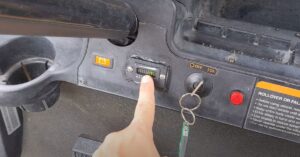What Should My Golf Cart Charger Read When Fully Charged?
Get ready for a turbo-charged discussion on golf cart chargers! You’ve been there, right? Staring at your charger and wondering what the numbers should read when it’s fully charged.
A fully charged golf cart charger should typically read around 48 volts. This reading indicates that your battery is in optimal condition, ready to power up your ride.
But wait, don’t zip off just yet! There’s more to this electrifying topic than meets the eye. Stick around as we navigate the ins and outs of golf cart chargers and how they work to keep you on course. It’s not rocket science; it’s just about understanding your equipment better. Buckle up, because we’re going full speed ahead into an engaging conversation that will leave you feeling like a pro!
Key Takeaways
- Optimal charging levels: Ensure your golf cart charger reads 100% when fully charged for optimal performance.
- Avoid overcharging: Monitoring your charger to prevent readings above 100% helps extend battery life and avoid potential damage.
- Battery maintenance: Consistently checking the charger reading when fully charged ensures proper battery care and longevity.
- Efficiency matters: Keeping an eye on the charger’s reading allows you to maximize energy usage and get the most out of each charge cycle.
How to determine if your golf cart charger is fully charged
Determining whether your golf cart charger is fully charged is essential for maintaining the performance and lifespan of your batteries. So, let’s find out how you can easily check if your golf cart charger has completed its charging cycle.
Firstly, look for an indicator light on the charger itself. Many modern chargers come equipped with an LED light that changes color to indicate the charging status. A green light usually indicates a full charge, while a red or amber light suggests the batteries are still charging.
If your charger doesn’t have an indicator light, don’t worry! You can also use a voltmeter to measure the voltage of your batteries. Before connecting the voltmeter, make sure you’ve unplugged the charger from both the wall outlet and your golf cart. Then, carefully attach the voltmeter’s positive lead to the positive terminal of one battery and connect the negative lead to its negative terminal.
Once connected, check if each battery reads around 12 volts. If they do, it means they’re fully charged. However, keep in mind that this method only provides a general indication and may not be entirely accurate.
To dig deeper into assessing battery charge levels accurately, you may consider using a hydrometer or specific gravity tester. These tools allow you to measure electrolyte density in each cell of your batteries accurately.
What voltage reading should you expect when your golf cart charger is fully charged?
When it comes to charging your golf cart, understanding the expected voltage reading is crucial for ensuring optimal performance. So, let’s find out what voltage reading you should expect when your golf cart charger is fully charged.
Typically, a fully charged golf cart charger will show a voltage reading between 38 and 48 volts. This range may vary depending on the specific make and model of your golf cart, as well as the type of battery being used.
To dig deeper into this topic, here are a few key factors that can influence the voltage reading:
Battery Type
Different types of batteries have different voltage requirements. For example, lead-acid batteries typically operate at lower voltages compared to lithium-ion batteries.
Charger Efficiency
The efficiency of your golf cart charger plays a significant role in determining the final voltage reading. Higher-quality chargers tend to deliver more accurate readings and ensure better overall performance.
Charging Duration
It’s important to note that the longer you charge your golf cart battery, the higher its voltage will be. However, it’s essential to follow manufacturer guidelines and avoid overcharging which can damage the battery.
Why is it important to know the charging status of your golf cart?
Knowing the charging status of your golf cart is crucial for ensuring optimal performance and longevity. Here are the reasons why:
Maintain Battery Life
Understanding the charging status allows you to monitor and control the battery’s health. By avoiding overcharging or undercharging, you can extend its lifespan and avoid costly replacements.
Plan Your Golfing Sessions
Knowing how much charge your golf cart has will help you plan your rounds effectively. You won’t have to worry about running out of power halfway through a game, allowing for a stress-free and uninterrupted experience.Promote Safety
A fully charged golf cart ensures that you have enough power to navigate uphill terrains or challenging courses without any sudden loss of energy. This promotes safety for both yourself and others on the course.
Avoid Unexpected Breakdowns
By keeping track of your golf cart’s charging status, you can identify any potential issues early on. If there are irregularities in the charging process, such as slow charging or quick battery drain, it could indicate underlying problems that need attention before they lead to an inconvenient breakdown during play.
Saves Time and Money
Being aware of your golf cart’s charging status helps prevent unnecessary trips to recharge or replace batteries prematurely due to improper usage or neglectful maintenance practices. This saves both time and money in the long run.Can overcharging damage your golf cart battery and charger?
Overcharging can indeed cause significant damage to both your golf cart battery and charger. Let’s explore the reasons why this is the case.
Firstly, overcharging can lead to excessive heat buildup in the battery. This can result in the electrolyte boiling inside the cells, causing them to become damaged or even rupture. Additionally, high temperatures can accelerate corrosion of the battery plates, reducing their overall lifespan.
Secondly, overcharging puts unnecessary strain on your charger. The constant flow of excess current can lead to overheating and potential component failure. This not only affects the performance of your charger but also poses a safety risk.
Furthermore, overcharging leads to increased water consumption in flooded lead-acid batteries. The continuous loss of water due to evaporation during charging cycles can cause irreversible damage to these types of batteries if not properly maintained.
To prevent such issues, it is crucial to use a charger specifically designed for your golf cart’s battery type and capacity. These chargers typically have built-in protections against overcharging. Regularly monitoring charge levels and disconnecting the charger once fully charged will also help avoid any potential harm caused by overcharging.
Are there any indicators or lights on the charger that show when it’s fully charged?
When it comes to charging your devices, it’s essential to know when they are fully charged to prevent overcharging and potential damage. Fortunately, many chargers come equipped with indicators or lights that provide valuable information about the charging status.
Let’s find out how these indicators work and what they mean:
LED Lights
One common type of indicator found on chargers is LED lights. These small, colored lights can be a great visual aid in determining the charging status. Typically, a red light indicates that the device is still charging, while a green light signifies that it has reached full charge.
Blinking Patterns
Some chargers use blinking patterns as an indicator of the charging progress. For example, a steady blink might indicate that the device is still charging, whereas a rapid blink could suggest that it is almost fully charged.
Solid vs. Flashing Lights
Another type of indicator you may encounter is either solid or flashing lights. A solid light often means that the device has finished charging and is ready for use, while a flashing light might indicate ongoing charging or an issue with the charger itself.
Multi-Color Indicators
In more advanced chargers, you may find multi-color indicators that offer additional information beyond just “charging” or “fully charged.” These indicators can provide insights into battery health, fast-charging capabilities, or even low-power warnings.
By understanding these different types of charger indicators and their meanings, you can stay informed about your device’s charging progress without constantly checking its battery percentage on screen.
Remember to consult your specific charger’s manual for accurate information about its indications since different manufacturers may have slightly different interpretations.
FAQs
Q: How can I determine if my golf cart charger is fully charged?
A: To know if your golf cart charger is fully charged, you can check the voltage reading on the charger. A fully charged battery typically reads around 12.6 to 12.8 volts.
Q: Is it possible for a golf cart charger to overcharge the batteries?
A: Yes, it is possible for a golf cart charger to overcharge the batteries. It is important to use a smart or automatic charger that has built-in safety features to prevent overcharging and protect the battery’s lifespan.
Q: What should I do if my golf cart charger does not reach a full charge?
A: If your golf cart charger does not reach a full charge, there may be an issue with either the battery or the charger itself. You should have them both checked by a professional technician who can diagnose and fix any problems.
Q: Can leaving my golf cart plugged in all the time damage the batteries?
A: Leaving your golf cart plugged in all the time can potentially damage the batteries due to overcharging. It is recommended to follow manufacturer guidelines and only leave the charger connected until it reaches a full charge, then disconnect it from power.





